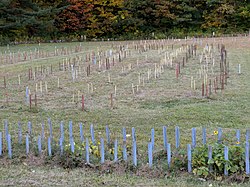
The Mohicans are an Eastern Algonquian Native American tribe that historically spoke an Algonquian language. As part of the Eastern Algonquian family of tribes, they are related to the neighboring Lenape, whose indigenous territory was to the south as far as the Atlantic coast. The Mohican lived in the upper tidal Hudson River Valley, including the confluence of the Mohawk River and into western New England centered on the upper Housatonic River watershed. After 1680, due to conflicts with the powerful Mohawk to the west during the Beaver Wars, many were driven southeastward across the present-day Massachusetts western border and the Taconic Mountains to Berkshire County around Stockbridge, Massachusetts.

Fonda is a village in and the county seat of Montgomery County, New York, United States. The population was 795 at the 2010 census. The village is named after Douw Fonda, a Dutch-American settler who was killed and scalped in 1780, during a Mohawk raid in the Revolutionary War, when the tribe was allied with the British.

The Wyandot people are Indigenous peoples of the Northeastern Woodlands of North America, and speakers of an Iroquoian language, Wyandot.
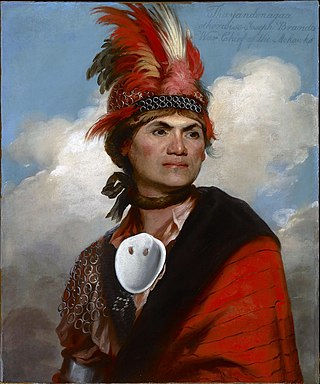
The Mohawk people are the most easterly section of the Haudenosaunee, or Iroquois Confederacy. They are an Iroquoian-speaking Indigenous people of North America, with communities in southeastern Canada and northern New York State, primarily around Lake Ontario and the St. Lawrence River. As one of the five original members of the Iroquois League, the Mohawk are known as the Keepers of the Eastern Door – the traditional guardians of the Iroquois Confederation against invasions from the east.

Kateri Tekakwitha, given the name Tekakwitha, baptized as Catherine, and informally known as Lily of the Mohawks, is a Catholic saint and virgin who was an Algonquin–Mohawk. Born in the Mohawk village of Ossernenon, in present-day New York State, she contracted smallpox in an epidemic; her family died and her face was scarred. She converted to Catholicism at age nineteen. She took a vow of perpetual virginity, left her village, and moved for the remaining five years of her life to the Jesuit mission village of Kahnawake, just south of Montreal. She was beatified in 1980 by Pope John Paul II and canonized by Pope Benedict XVI at Saint Peter's Basilica on 21 October 2012.
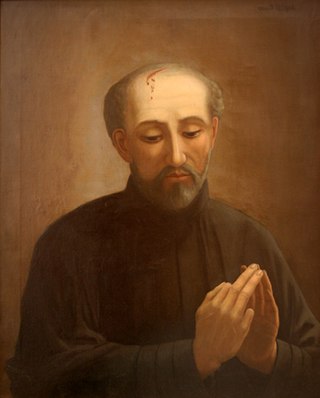
Isaac Jogues, SJ was a French missionary and martyr who traveled and worked among the Iroquois, Huron, and other Native populations in North America. He was the first European to name Lake George, calling it Lac du Saint Sacrement. In 1646, Jogues was martyred by the Mohawk at their village of Ossernenon, near the Mohawk River.

The Kahnawake Mohawk Territory is a First Nations reserve of the Mohawks of Kahnawá:ke on the south shore of the Saint Lawrence River in Quebec, Canada, across from Montreal. Established by French Canadians in 1719 as a Jesuit mission, it has also been known as Seigneury Sault du St-Louis, and Caughnawaga. There are 17 European spelling variations of the Mohawk Kahnawake.
The Seven Nations of Canada was a historic confederation of First Nations living in and around the Saint Lawrence River valley beginning in the eighteenth century. They were allied to New France and often included substantial numbers of Roman Catholic converts. During the Seven Years' War (1756–1763), they supported the French against the British. Later, they formed the northern nucleus of the British-led Aboriginal alliance that fought the United States in the American Revolutionary War and the War of 1812.

Auriesville is a hamlet in the northern part of New York state and west of Albany. It was the site of Ossernenon, a Mohawk village where French Jesuits established a mission. This operated from 1667 until 1684, when the Mohawk destroyed it as part of continuing confrontations with French colonists. Auries is said to have been the name of the last Mohawk known to have lived there. Later settlers named the village after him.
Jacques de Lamberville was a Jesuit missionary and the younger brother of Jean de Lamberville, also a missionary. He came to New France from France at the age of 34 and became part of the Iroquois missions. There, his most famous convert was Kateri Tekakwitha.
Pierre Cholenec was a French Jesuit missionary and biographer in New France. He ministered to First Nations in present-day Canada, particularly at the village of Kahnawake south of Montreal. He served as superior of the Jesuit residence in Montréal. He is known for writing multiple biographies about Kateri Tekakwitha which contributed to her canonization in 2012 by Pope Benedict XVI.
Fort Hunter is a hamlet in the Town of Florida in Montgomery County, New York, United States, west of the capital at Albany, on the south bank of the Mohawk River and on the northeast bank of Schoharie Creek.

The National Shrine of the North American Martyrs, also known as the Shrine of Our Lady of Martyrs, is a Roman Catholic shrine in Auriesville, New York dedicated to the three Jesuit missionaries who were martyred at the Mohawk Indian village of Ossernenon in 1642 and 1646.

The Iroquois, also known as the Five Nations or the Six Nations and by the endonym Haudenosaunee, are an Iroquoian-speaking confederacy of Native Americans and First Nations peoples in northeast North America and Upstate New York. They were known during the colonial years to the French as the "Iroquois League", and later as the "Iroquois Confederacy". The English called them the "Five Nations", including the Mohawk, Oneida, Onondaga, Cayuga, and Seneca. After 1722, the Iroquoian-speaking Tuscarora from the southeast were accepted into the confederacy, which became known as the Six Nations.
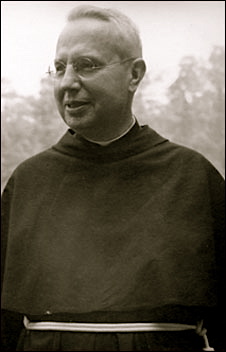
Rev. Thomas Grassmann, OFM Conv, was a Conventual Franciscan friar, historian and archaeologist of Colonial New York, who discovered the site of the Mohawk American Village of Caughnawaga near Fonda, New York.
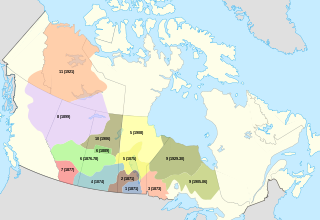
The Michel Band is an Indigenous nation of central Alberta, Canada, which the Government of Canada recognized as a nation and treaty partner from 1878 to 1958. The descendents of that historic band, now organized as an association called the Michel First Nation, are engaged in legal and political action to regain recognition.
Caughnawaga is a former town in then Tryon County, later Montgomery County, New York, United States.
Tionondogen was the westernmost and most important of the three large palisaded towns of the Mohawk Nation of Iroquois. These towns were termed "castles" by the Europeans. Because of its position as the farthest upstream on the Mohawk River Tionondogen is often referred to as the "Upper Castle".
Claude Chauchetière was a French Jesuit missionary, priest, biographer, and painter. Claude Chauchetière is well known for his published work Annual Narrative of the Mission of the Sault from Its Foundation Until the Year 1686 which detailed his time in New France as a Jesuit missionary. For most of his mission work he was placed in the village of Kahnawake where he encountered Kateri Tekakwitha, an Algonquin-Mohawk Jesuit convert, an encounter that immensely impacted his spiritual life. Later on Chauchetière would also actively work to get Kateri Tekakwitha canonized as a saint.
Dean Richard Snow is an archeologist and an American historian who is Professor Emeritus of Anthropology at Pennsylvania State University who has conducted extensive archeological research on the Iroquois Indian nations of north-eastern America, and other indigenous peoples in the highlands of Mexico, and in Spain and France. Snow specializes in Ethnohistory and is considered an authority in this field. Snow has conducted archaeological field investigations along the Mohawk Valley and at the Saratoga battlefield. In 1977 he was asked by the U.S. Department of Justice to act as a historical consultant involving Indian land claims against the state of Maine. Snow was raised in Sleepy Eye, Minnesota. He married Janet Keller in 1963. They and their three adult children all live in the Saratoga region in upstate New York. Snow has written many books and journal articles on North-American archeology, Indian nations and related subjects.
